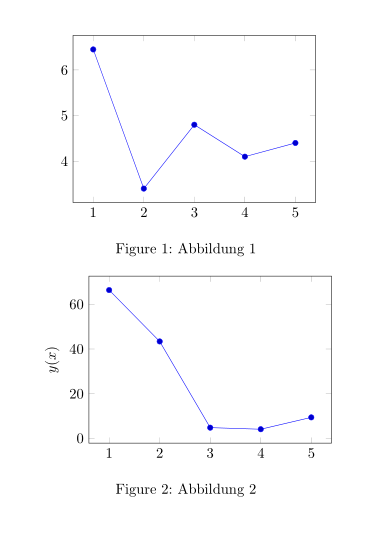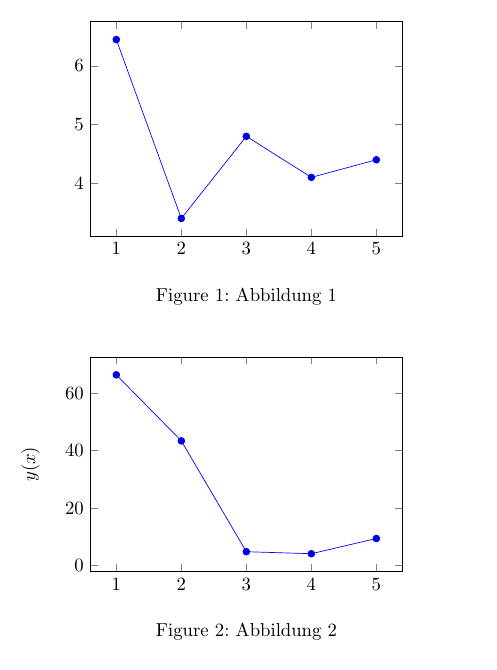|
Ich habe zwei Für beide Diagramme gebe ich mit \documentclass{scrartcl} \usepackage{pgfplots} %\pgfplotsset{compat=1.9}% bei Nutzung von writeLaTeX auskommentieren \pgfplotsset{width=8cm,height=6cm} \begin{document} \begin{center} \begin{tikzpicture} \begin{axis} \addplot coordinates {(1,6.45)(2,3.4)(3,4.8)(4,4.1)(5,4.4)}; \end{axis} \end{tikzpicture} \captionof{figure}{Abbildung 1} \end{center} \begin{center} \begin{tikzpicture} \begin{axis}[ylabel = {$y(x)$}] \addplot coordinates {(1,66.4)(2,43.4)(3,4.8)(4,4.1)(5,9.4)}; \end{axis} \end{tikzpicture} \captionof{figure}{Abbildung 2} \end{center} \end{document}
|
|
Das einfachste scheint mir, beiden \documentclass{scrartcl} \usepackage{pgfplots} \pgfplotsset{width=8cm,height=6cm} \begin{document} \begin{center} \begin{tikzpicture}[trim axis left] \begin{axis} \addplot coordinates {(1,6.45)(2,3.4)(3,4.8)(4,4.1)(5,4.4)}; \end{axis} \end{tikzpicture} \captionof{figure}{Abbildung 1} \vspace{2\baselineskip} \begin{tikzpicture}[trim axis left] \begin{axis}[ylabel = {$y(x)$}] \addplot coordinates {(1,66.4)(2,43.4)(3,4.8)(4,4.1)(5,9.4)}; \end{axis} \end{tikzpicture} \captionof{figure}{Abbildung 2} \end{center} \end{document}
|
|
Neben dem Vorschlag von @Clemens, der laut Dokumentation von Einfach nutzbar ist die \begin{axis}[...,ylabel style={overlay},yticklabel style={overlay},...] Als weitere Möglichkeit kann man auch \documentclass{scrartcl} \usepackage{pgfplots} \pgfplotsset{width=8cm,height=6cm} \newcommand\myBoundingBox{ \pgfresetboundingbox% bisher ermittelte Bounding Box wird zurückgesetzt % der folgende Code bestimmt die Bounding Box für die Abbildung \path(current axis.below south west)rectangle (current axis.above north east); } \begin{document} \begin{center} \begin{tikzpicture} \begin{axis} \addplot coordinates {(1,6.45)(2,3.4)(3,4.8)(4,4.1)(5,4.4)}; \end{axis} \myBoundingBox \end{tikzpicture} \captionof{figure}{Abbildung 1} \end{center} \begin{center} \begin{tikzpicture} \begin{axis}[ylabel = {$y(x)$}] \addplot coordinates {(1,66.4)(2,43.4)(3,4.8)(4,4.1)(5,9.4)}; \end{axis} \myBoundingBox \end{tikzpicture} \captionof{figure}{Abbildung 2} \end{center} \end{document} Alternativ kann man die ... \begin{pgfinterruptboundingbox} \begin{axis}[... ... \end{axis} \end{pgfinterruptboundingbox} \useasboundingbox(current axis.below south west)rectangle (current axis.above north east); ... Alle drei Vorschläge bieten für andere Anwendungen auch die Möglichkeit, die Beschriftung der x-Achse aus der Festlegung der Bounding Box auszuschließen. |


